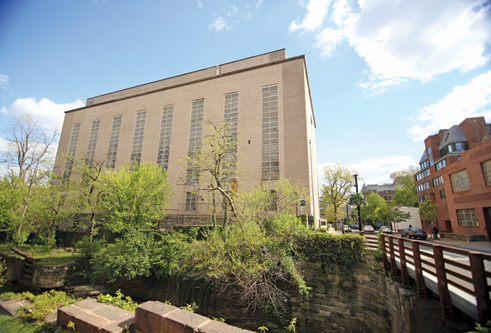Heating Plant Receives Landmark Designation

By GRACE BIRDCurrent Staff WriterThe West Heating Plant is now a historic landmark, presenting a potential obstacle to the site’s long-planned redevelopment into luxury apartments and a public park.The D.C. Historic Preservation Review Board voted 5-3 in favor of landmark designation last Thursday, reversing its earlier determination that the 1948 heating plant is unworthy of such a status. Members had planned to review the redevelopment plans — which include largely demolishing the vacant industrial building — but pushed deliberations off to Nov. 16 due to time constraints.Regardless of the plant’s new landmark status, the project team has no current plans to alter designs for the 110-foot, 60-unit luxury apartment house and 1-acre park.“Obviously we are very disappointed. It was an unprecedented decision by the board,” developer Richard Levy of the Levy Group told The Current. “But it doesn’t change anything.”Because the heating plant was already a contributing building to the Georgetown Historic District, the planned demolition needed approval by the Mayor’s Agent for Historic Preservation — who can overrule preservation concerns for an overriding public interest — even before the individual landmark designation. Levy said the team will make its case in January.The latest landmark application was the DC Preservation League’s second attempt at designating the plant, after the preservation board narrowly rejected a previous attempt in 2015. The organization cited the plant’s historical and artistic significance as grounds for its designation. Completed in 1948, the Georgetown plant was built to serve new federal buildings and relieve Southwest’s overworked Central Heating Plant.“The size and massing gives the building a monumental presence near the Georgetown waterfront,” Rebecca Miller, executive director of the DC Preservation League, said at the Nov. 2 hearing. The West Heating Plant represents a shift from art deco to the “minimalist moderne style,” Miller said, evident in its “smooth wall plains, linear brick corner embellishments and subtle architectural details.”The Historic Preservation Office backed the landmark designation, opposing redevelopment plans because the current designs do not “achieve meaningful historic preservation,” according to the agency’s report. The staff also raised questions about the proposed 110-foot height, asking whether it was compatible with the Georgetown Historic District.The proposal has won broad support from the Georgetown community and federal stakeholders. The U.S. Commission of Fine Arts approved the designs in May, while Advisory Neighborhood Commission 2E (Georgetown, Burleith), the Citizens Association of Georgetown and the Friends of Georgetown Waterfront Park also support the plans.Richard Hinds, general counsel for the Georgetown Citizens Association, said the Historic Preservation Review Board “made a mistake” with its designation. “The fact that it’s a landmark adds a certain extra hurdle that the developer has to meet,” Hinds said.Developers contend that the plant is beyond repair. Joel Silverman, the development’s head of construction, said at the meeting the site “is not a building” but rather an “enclosure for a steam plant.” The only viable wall, Silverman said, is on the west side at 29th Street. More than 80 percent of the structure is not laterally supported, Silverman added, meaning it doesn’t have horizontal slabs.“It was not designed to do anything other than to simply house steam boilers,” Silverman said. Meanwhile, although the steam boilers protected the building from moisture when they were operating, deterioration has escalated since the plant closed nearly 20 years ago. The site is also infested with harmful chemicals, including mercury, lead, asbestos and polychlorinated biphenyl, he said.Critics of the current proposal argue that the development team should have recognized the constraints presented by the building’s condition when they purchased the property from the General Services Administration at auction in early 2013.
This article appears in the Nov. 8 issue of The Georgetown Current newspaper.





